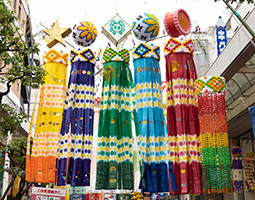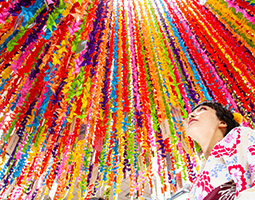August 2022
- English
- 日本語
The Sendai Tanabata Festival

A Sendai City shopping arcade during the Tanabata Festival 
Close-up of Sendai Tanabata Festival streamers 
A festival-goer wearing yukata (Japanese summer kimono) under a decoration made from origami cranes

The Sendai Tanabata Festival, in which about 3,000 bamboo branches are hung with gorgeous decorations, is a festival that has been adding color to the Japanese summer for more than 400 years.

The Tanabata Festival, also known as the Star Festival and meaning “Evening of the Seventh,” is an event that has long been held in homes and public places in Japan. Star festivals were in fact first held as a court event in Japan, but gained widespread popularity by the early seventeenth century. The festival is held on around July 7 or August 7i across Japan.
In the Tanabata Festival, people write their wishes on strips of colored paper and hang them on bamboo branches in the hope their wishes reach the stars. The practice originates in a legend from ancient China that on this night, the male star Kengyusei (Altair, the head star of the constellation Aquila) and the female star Shukujosei (the α star Vega of the constellation Lyra), which are on either side of the Milky Way, have a once-a-year meeting. As the Tanabata Festival (in August) coincides with the Bon festival in which ancestral spirits are welcomed home, the two events often take place together.
The Tanabata Festival is celebrated by communities across Japan, with one of the most famous being the Sendai Tanabata Festival in Sendai City, Miyagi Prefecture. Held every August 6 to 8, the festival features bamboo stems 10 meters or longer which are displayed at Sendai Station and in the surrounding shopping streets. In Sendai City, more than 3,000 Tanabata ornaments are displayed for the pleasure of residents and visitors, mostly in the numerous shopping arcades, and are gorgeously decorated with colorful washi paper streamers, paper strips, origami cranes and other ornaments. The festival is said to go back 400 years to when Date Masamune, first lord of the Sendai Clan (1567–1636), started it to encourage interest in the arts among women and children in the area.
Yamaguchi Tetsuo, the event manager in charge of the bamboo decorations at the Sendai Tanabata Festival Support Association, which organizes the Sendai Tanabata Festival, says, “Date Masamune, who built the castle and town of Sendai in the seventeenth century, was a warlord with a deep interest in the arts. The Sendai Tanabata Festival is thought to be a strong reflection of his aesthetic sense.”
Yamaguchi adds, “Green bamboo that stretches straight to the heavens is considered sacred by Japanese people, and people in Sendai are especially fond of bamboo as it appears on the Date family crest, the Sendai Sasa.”
The bamboo used for the decorations is mainly mosochiku bamboo (see here) cut from bamboo forests on the outskirts of Sendai City especially for this festival.
The Sendai Tanabata Festival features seven main kinds of decorations. These include paper strips with wishes written on them, origami cranes for good health and longevity, drawstring purses for thrift, savings, and prosperous business, casting nets for abundant fishing catches, and streamers for improvements in weaving and handicraft skills. The streamers consist of washi paper strips about three meters long with different colorful patterns that hang from the top of the bamboo poles. They are thought to repel evil spirits, and it is customary to hang a set of five from one bamboo stem. They are beautiful to look at as they gently sway in the breeze.

Yamaguchi says, “The charm of Sendai Tanabata is the handmade decorations made of natural materials such as bamboo and washi paper. We will continue to protect this traditional event in Sendai.”
On August 8, after the festival is over, the shopping streets are filled with people taking down the decorations. Once the bamboo has fulfilled its purpose, it is recycled as business cards and postcards or reborn as bamboo charcoal under the “Sendai Tanabata Bamboo Paper Project” that began in 2012.
* According to the Japanese lunar calendar, July 7 corresponds to the present month of August.

